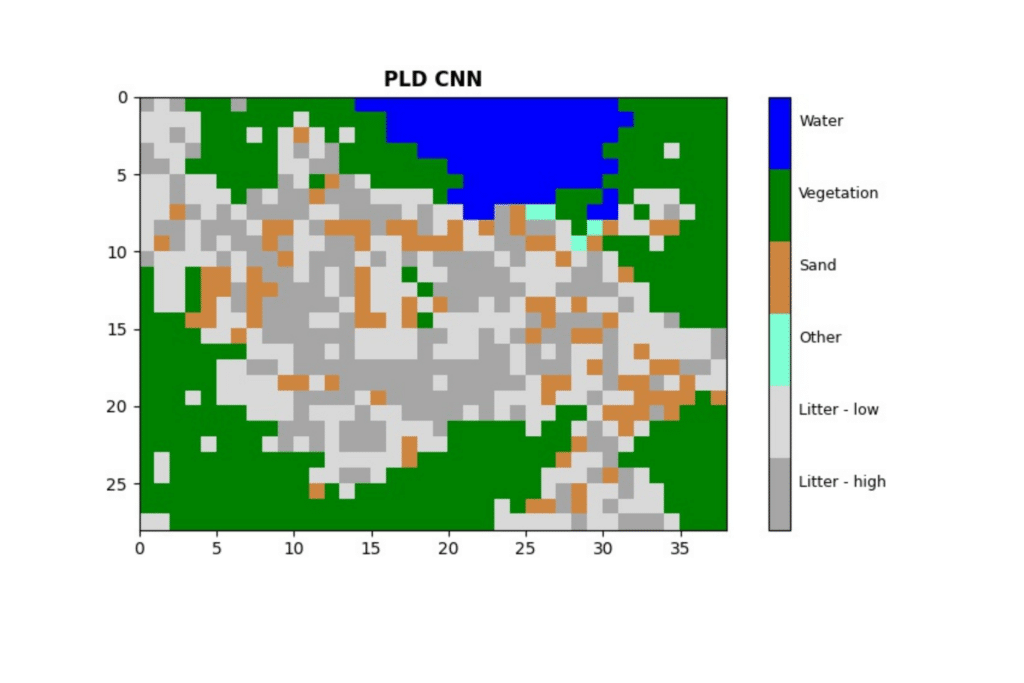To establish an operational service at the iMagine platform for ingestion, storage, analysis and processing of drone images, observing litter floating at surface waters in seas, rivers and lakes, and lying at beaches and shores, delivering standardised classified litter data sets, which are fit for purpose of environmental management and indicators.
Aim
Development actions during iMagine
Formulating and adopting standard protocols for drone observation and for classifying observed litter objects, making use of EU guidelines (TG-ML)
Refining processing methodology and setting up operational environment at iMagine platform, with AI image analysis service and databases for ingestion of ‘raw’ and annotated drone images, and classified litter data, resulting from the image processing
Developing guidance and training material for uptake of litter observation by drones and observed image processing data by researchers, environmental agencies, NGOs and other users (including citizen science)
Reaching out to users for uptake and provide support and training.
Objective and Challenge
This use case aims to create a functional service on the iMagine platform that can ingest, store, analyze, and process drone images to identify and classify floating litter in bodies of water and on beaches. The goal is to provide standardized data sets on litter for environmental management purposes. The technology behind this service involves using UAV surveys at different altitudes and employing two CNN deep neural networks to quantify and characterize the observed litter. This approach has been successfully applied in various countries through collaborations with the World Bank Group and NGOs, supporting local stakeholders and clean-up operations. The training subset of the model has been made available on Zenodo.
However, the current service needs more user-friendliness and requires several manual steps. To address these issues, the project aims to incorporate the following features into the service using the iMagine platform:
- Easy storage and access to custom data
- User-friendly API
- Ready-to-use environment (e.g., Docker)
- Information on image processing requirements
- Simplified usage of provided test data for retrained mode
- Documentation and step-by-step guides
Sample Results
Use Case Resources
Collaboration with EMODnet
The involvement of OGS in the use case and service development is crucial for providing a valuable contribution to the data collection maintained by EMODnet.
The European Marine Observation and Data Network (EMODnet) is the European Commission (EC) in situ marine data service of the EC Directorate-General Maritime Affairs and Fisheries (EC DG MARE). Established in 2009, EMODnet plays a pivotal role as a trusted source of in situ marine environmental and human activities data and data products, serving a diverse user base across various sectors.
The EMODnet Portal is a single access point to all EMODnet services, providing easy and free access to a wealth of marine data, metadata, and data products. Covering seven disciplinary themes – bathymetry, geology, physics, chemistry, biology, seabed habitats and human activities – EMODnet spans the entire marine environment from coast to open ocean, surface to deep seafloor, whilst also offering data and information on the Blue Economy operations, from vessel density and offshore platform sitings, to hosting EU Member State Maritime Spatial Plans.
EMODnet Chemistry is one of the thematic groups within EMODnet, coordinated by OGS. It provides easy access to marine chemical data, standardised, harmonised and validated data collections and data products for visualisation. These are relevant for the European marine environmental policies to assess the status and trends of ecosystems as covered in the Marine Strategy Framework Directive (MSFD).
The MSFD Descriptor 10 concerns Marine Litter for which EMODnet Chemistry has developed and is managing the first pan-European Marine Litter Database (MLDB) on the advice of the MSFD Technical Group on Marine Litter of the Marine Strategy Framework Directive (MSFD) and in close cooperation with relevant stakeholders in the EU, such as the European Commission’s Joint Research Centre, the Regional Sea Conventions and the International Council for the Exploration of the Sea.
The EMODnet Chemistry Marine Litter Database is a major milestone in the harmonisation of available information at the European level, supporting the establishment of European baselines and threshold values for the MSFD. The approach for Marine Litter concerns beach litter, seafloor macrolitter data and microlitter data on the sea surface and in sediment.
The iMagine cooperation of OGS with DFKI focuses on beach litter and arranging that the iMagine results of the Marine Litter Monitoring use case can be used for EMODnet Chemistry purposes.

Image credit: Naja Bertolt Jensen / Ocean Image Bank











